Why does my Panasonic WH-ADC0309K6E5 system not heat up instantly?
- CCasey Miller DDSAug 5, 2025
The system may take some time to heat up the water if it starts operating at a cold water temperature.
Why does my Panasonic WH-ADC0309K6E5 system not heat up instantly?
The system may take some time to heat up the water if it starts operating at a cold water temperature.
Why is my Panasonic Heat Pump system hard to heat up?
When the panel and the floor are heated simultaneously, the warm water temperature may decrease, which may reduce the heating ability of the system. Also, when the outdoor air temperature is low or the preset water outlet temperature is low, the system may need a longer time to heat up. Check that the discharge outlet or intake inlet in the outdoor unit is not blocked by any obstacle, such as a pile of snow.
Why does my Panasonic Heat Pump operation start automatically when the timer is not set?
If the timer is not set but the operation starts automatically, it is because the sterilization timer has been set.
Why is my Panasonic WH-ADC0309K6E5 Heat Pump making a loud refrigerant noise?
Loud refrigerant noise that continues for several minutes is caused by protection control during de-ice operation when the outdoor ambient temperature is lower than -10 °C.
Why does my Panasonic WH-ADC0309K6E5 Heat Pump outdoor unit not operate?
The outdoor unit may not operate because of the protection control of the system when the outdoor temperature is out of the operating range.
Why is the backup heater automatically turned ON in my Panasonic WH-ADC0309K6E5 when it is disabled?
The backup heater automatically turns on due to the protection control of the indoor unit heat exchanger.
Covers warnings for different hazard levels and prohibited actions using symbols.
Specific safety guidelines for the appliance units, including child safety.
Explanation of each button and operational indicator on the remote controller.
Details various display modes, icons, and temperature zone indicators.
Guide to choosing the language for the remote controller display.
Instructions for configuring the system clock and date.
Steps for accessing and selecting options from the Quick Menu.
How to activate or deactivate Domestic Hot Water heating.
How to set quiet operation levels and timer patterns.
Instructions for manually engaging the heater function.
Guide to setting, editing, and copying timer patterns for daily operation.
Procedures for clearing frozen pipes and resetting system errors.
How to lock/unlock the controller and reset passwords.
Settings for weekly, holiday, and quiet timers.
Accessing energy monitor, system info, errors, compressor, and heater status.
Customizing remote control, touch sound, LCD, backlight, clock, and date.
Setting display language, password, and service contact details.
Initial system setup including PCB, zones, sensors, and heater capacity.
Settings for DHW capacity, buffer tanks, base pan heaters, and sensors.
Detailed configuration of bivalent connection modes and temperature settings.
Settings for SG ready and Smart control patterns for bivalent systems.
Configuring electricity and boiler prices for energy cost optimization.
Defining seasons and setting operational schedules for energy pricing.
Enabling external switches and configuring solar connection parameters.
Configuring error signals, demand control, SG ready, and circulation liquid.
Settings for forced heating, defrost, pump control, DHW defrost, and heating control.
Setting up various external meters for energy generation and consumption monitoring.
Configuration for the electrical anode's operation.
Accessing the main operation modes: Heat, Cool, Auto, and Tank.
Detailed temperature settings for heating operations.
Detailed temperature settings for cooling operations.
Configuration for tank floor operation, heat-up time, and sterilization.
Settings for pump speed, pump down, and dry concrete preparation.
Setting service contacts and configuring remote control management.
Procedures for cleaning the indoor/outdoor units and the water filter.
Checking safety valves and advice for extended periods of non-use.
Steps for topping up and venting the system's circuit.
Outlines user checks and dealer responsibilities for maintenance.
Explains normal operational sounds, delays, and steam emissions.
Basic checks for efficiency, noise, and system operation before calling for service.
A comprehensive list and explanation of system error codes.
Safety guidelines for using the network adaptor and remote operation.
Information on proper disposal and recycling of old equipment in the EU and other countries.
Explains the meaning of various symbols used throughout the manual.
Covers warnings for different hazard levels and prohibited actions using symbols.
Specific safety guidelines for the appliance units, including child safety.
Explanation of each button and operational indicator on the remote controller.
Details various display modes, icons, and temperature zone indicators.
Guide to choosing the language for the remote controller display.
Instructions for configuring the system clock and date.
Steps for accessing and selecting options from the Quick Menu.
How to activate or deactivate Domestic Hot Water heating.
How to set quiet operation levels and timer patterns.
Instructions for manually engaging the heater function.
Guide to setting, editing, and copying timer patterns for daily operation.
Procedures for clearing frozen pipes and resetting system errors.
How to lock/unlock the controller and reset passwords.
Settings for weekly, holiday, and quiet timers.
Accessing energy monitor, system info, errors, compressor, and heater status.
Customizing remote control, touch sound, LCD, backlight, clock, and date.
Setting display language, password, and service contact details.
Initial system setup including PCB, zones, sensors, and heater capacity.
Settings for DHW capacity, buffer tanks, base pan heaters, and sensors.
Detailed configuration of bivalent connection modes and temperature settings.
Settings for SG ready and Smart control patterns for bivalent systems.
Configuring electricity and boiler prices for energy cost optimization.
Defining seasons and setting operational schedules for energy pricing.
Enabling external switches and configuring solar connection parameters.
Configuring error signals, demand control, SG ready, and circulation liquid.
Settings for forced heating, defrost, pump control, DHW defrost, and heating control.
Setting up various external meters for energy generation and consumption monitoring.
Configuration for the electrical anode's operation.
Accessing the main operation modes: Heat, Cool, Auto, and Tank.
Detailed temperature settings for heating operations.
Detailed temperature settings for cooling operations.
Configuration for tank floor operation, heat-up time, and sterilization.
Settings for pump speed, pump down, and dry concrete preparation.
Setting service contacts and configuring remote control management.
Procedures for cleaning the indoor/outdoor units and the water filter.
Checking safety valves and advice for extended periods of non-use.
Steps for topping up and venting the system's circuit.
Outlines user checks and dealer responsibilities for maintenance.
Explains normal operational sounds, delays, and steam emissions.
Basic checks for efficiency, noise, and system operation before calling for service.
A comprehensive list and explanation of system error codes.
Safety guidelines for using the network adaptor and remote operation.
Information on proper disposal and recycling of old equipment in the EU and other countries.
Explains the meaning of various symbols used throughout the manual.

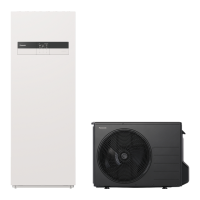

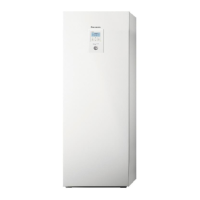
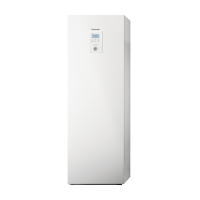


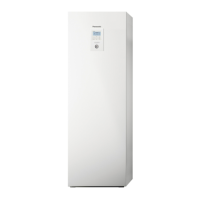
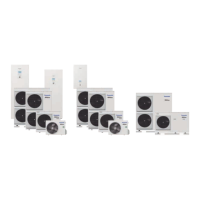


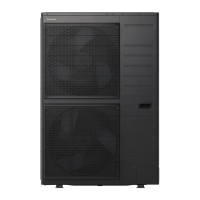
